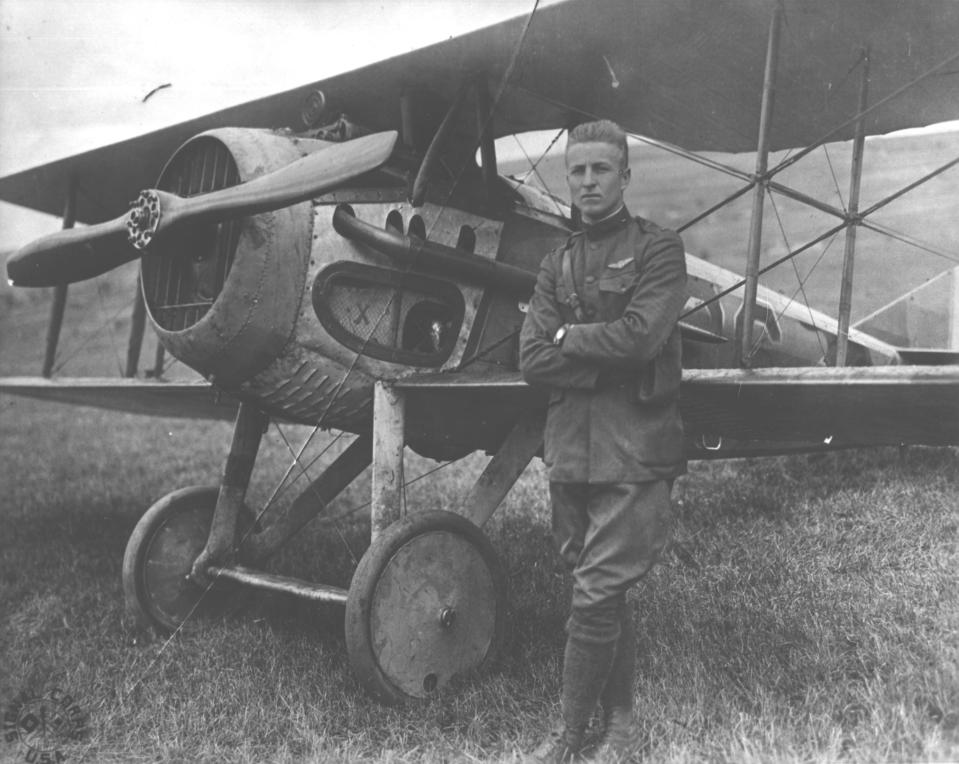A look back at WWI ace Frank Luke of Arizona, awarded posthumous Medal of Honor
- Oops!Something went wrong.Please try again later.
Frank Luke, namesake for the famous Luke Air Force Base in Arizona, in May 1919 posthumously was awarded the Medal of Honor for his 40 days spent as a fighter pilot on the Western Front of World War I.
During his brief time on the front, Luke was credited with 19 aerial victories, 18 of which were achieved between Sept. 12 and Sept. 29, 1918, a 17-day span, a feat unsurpassed by any other pilot in the war.
The Arizona Republic (then The Arizona Republican) extensively covered the ceremony and Luke's career. The young pilot from Arizona had made national news for his wartime record even before his death.
“Downtown Phoenix was electrified last evening when The Republican's bulletin board gave the gist of the dispatch from the front recounting the truly marvelous performance of Frank Luke Jr.," The Republican reported on Sept. 19, 1918.
Ten days later, Luke was dead.
Luke was born in Phoenix, Territory of Arizona, on May 19, 1897; his father was from Germany. A son of the Wild West, Luke was described by many as a free and rugged spirit. He often rode his horse miles in the desert, whether it be for camping out in the quiet Arizona night or to ride to nearby towns such as Globe and Miami. He was known in these towns for his skills and success in the bare-knuckle boxing scene.
While working at a mining site in Globe, Luke heard news of the United States' entrance into World War I. Shortly after, in 1917, a 20-year-old Luke enlisted in the Aviation Section, U.S. Signal Corps, which became the U.S. Air Force.
Although his time in combat was short, Luke’s accomplishments as a fighter ace had made national news.
In what was considered a friendly competition between American fighter aces, Luke built a reputation as a brash and confident ace who often flew alone to hunt German balloons.
His tendency to fly alone and an apathetic attitude toward authority made him a polarizing figure among his peers. Some considered him too arrogant and foolhardy for his own good. However, a handful of commanding officers were fond of the Arizonan, so he was able to continue his unscheduled balloon hunting.
Military balloons were considered the most dangerous targets for WWI fighter pilots. German anti-air defense around these strategic sites were fierce and unforgiving. On five separate occasions, Luke’s airplane was so badly damaged he had to complete his next mission in a new one. Part of the national coverage on Luke were reports of his tendency to hunt balloons specifically. During his 17-day hot streak in which he downed 18 aircraft, 14 were balloons, earning him the nickname the “Arizona Balloon Buster.”
Luke's final flight was on Sept. 29, 1918, about two months before the war ended.
There's more than one version of the story of his final flight, with many greatly exaggerated.

The Republican reported at the time that potentially hundreds of German infantrymen had swarmed his aircraft as he went out in a final blaze of glory. Air Force Museum experts now have a fairly reliable timetable of Frank Luke's final flight. The facts of Luke's final hours may not be as dramatic as some portrayals have, but his final actions cemented his place as the first airman awarded the Medal of Honor.
Luke had reached the small French town of Murvaux, 37 miles north of Verdun, shortly before 7 p.m.
Just outside the town was his final target, a German balloon heavily protected by enemy machine guns fortified on a nearby hill. Descending upon the balloon alone, every gun in the area fired upon him. Swinging back toward the gunfire, Luke destroyed the balloon on his second pass through and shortly after was struck by a machine gun bullet.
Luke was mortally wounded but able to land his airplane 2 miles from the destroyed balloon site.
Some tall tales have him going out by unloading his pistol on the German infantrymen who surrounded his plane. Although his body was found 200 yards away from his landing spot, with his sidearm pistol missing a few rounds, it’s unlikely any Germans returned fire or were even close to him at the time of his death. Air Force Museum experts believe Luke began his final attack on the balloon at 6:55 p.m., landed his plane, and then died from his fatal gunshot wound at 7:04 p.m.
On May 29, 1919, Frank Luke Sr. accepted from Congress the Medal of Honor, the highest U.S. military honor, on his son's behalf. The Arizona Republican covered the ceremony at the time, declaring that “No greater achievements were accomplished by any individual during the war than were those officially accredited to the Phoenix youth — and he was only a youth.”
It wasn't long before Luke Air Force base began operation west of Phoenix. The air base, named after the daring fighter pilot from Arizona, would become the largest fighter training base of its kind during World War II and remains an Arizona landmark.
This article originally appeared on Arizona Republic: Frank Luke, ace fighter pilot, awarded the posthumous Medal of Honor

